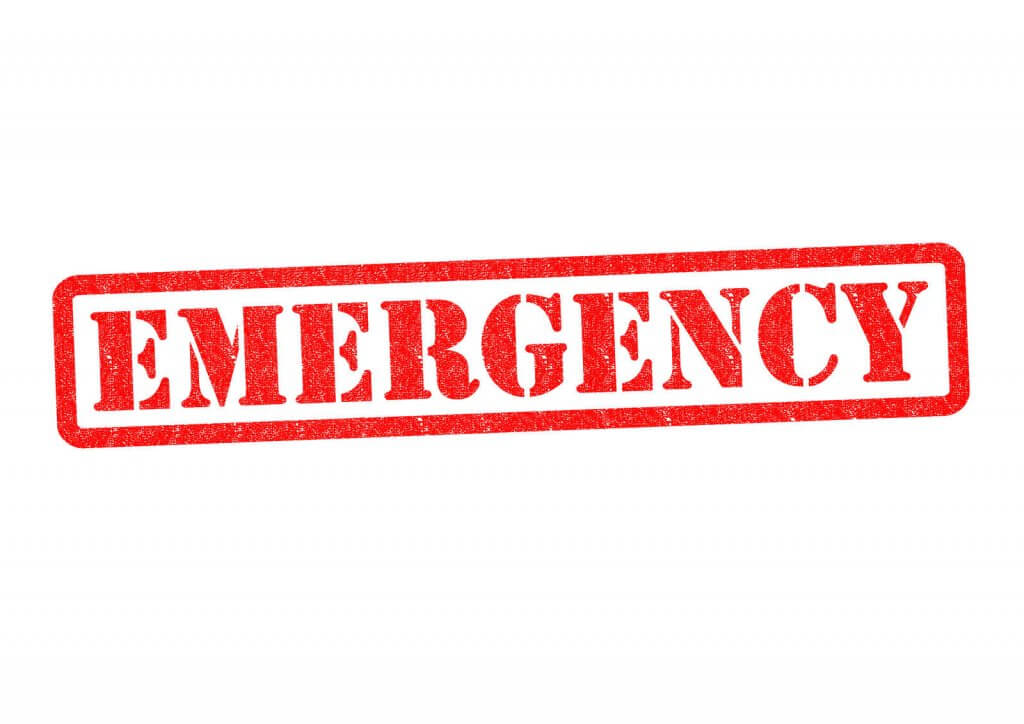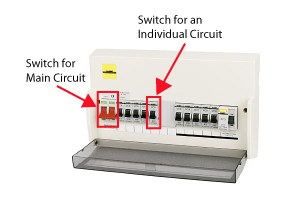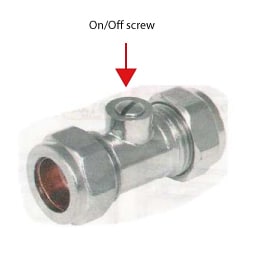
This article provides a guide to for tenants to help to resolve emergency procedures. The document covers utilities of water, gas and electric. If you do not find the information required, please contact K&G Lettings Limited. If the problem is not urgent, please complete a maintenance request form.
Electrical Safety
Electric fuse box location
If the power is suddenly lost, it is possible that the consumer unit has ‘tripped’ or there is a disruption to the wider service. See section on ‘determining whether utilities have been disrupted’ for how to determine whether there is a service disruption.
If the consumer unit trips, locate the consumer unit using the details in your properties welcome pack. Determine whether any of the switches have moved from the on to the off position. Move any switches which are in the off position back into the on position (see figure 1). Test to see whether this has restored the power. If it has not, the problem is likely to be a service disruption effecting your neighbours. See section on ‘determining whether utilities have been disrupted’ for how to determine whether there is a service disruption.

Figure 1: A Consumer unit Electric appliance does not work
In the first instance consult the instructions for the appliance which will be contained in the welcome pack for your property. If this does not resolve the problem ensure the appliance is turned off and then contact K&G Lettings Limited.
Water Safety
Turning off the water to the entire house
Turn off the main stop cock, which is usually located outside the property. Reference the Welcome Pack for property for the exact location.
Isolating appliances
Many of the appliances (toilets, sinks) have been fitted with isolator valves which allow the supply of water to be stopped to a leaking appliance. In order to use these isolators you will need a flat screwdriver. To stop the flow of water, rotate the screw on the top of the isolator valve, see picture. You should hear the flow of the water to the appliance stop.

Figure 2: An isolator valve
Fire Safety
Safety Tips
Ensure hallways, stairways, landings, passages etc. that form part of the escape route are kept free from obstruction, flammable materials and trip hazards (for example, worn carpets), at all times. Ensure that lighting is always functional and time switches correctly adjusted. Escape route lighting must not operate from tenants power supplies. Ensure the stairs, handrails and balustrade are in good repair at all times.
Do not leave children alone, especially in rooms where heating or cooking appliances are in use, and keep matches and lighters out of their reach. Do not fill chip pans more than half full of oil or fat and never leave the pan unattended with the heat turned on. If a chip pan fire occurs, do not move it or throw water at it – turn off the heat if it is safe to do so, smother the flames with a damp cloth, fire blanket or the chip pan lid and leave the pan to cool for at least half an hour.
Do not smoke within the house – it is a major cause of fires in the home. Always finish last cigarettes or pipes before going into the house and make sure that it is put out properly.
Wherever possible, portable heaters should not be used but when this cannot be avoided they should be kept well away from furniture and furnishings. Ensure that nothing can fall onto them and that they are in a place where they cannot be knocked over. Routine precautions to be followed at bedtime should include the following: Switch off all
electrical appliances (except those which are designed to be left on all the time) and remove the plugs carefully – not by pulling the flex. Check for burning cigarettes or pipes. Put a guard on any open fire. Close the doors of unoccupied rooms.
Smoke Alarms
Test smoke alarms every 6 weeks and replace batteries.
Symptoms of Carbon Monoxide poisoning:
- Fatigue
- Headaches
- Flu like symptoms such as nausea
- Chest pains
- Sudden giddiness when standing up
- Sickness, diarrhoea and stomach pains
- Erratic behaviour
If you think your appliance is spilling Carbon Monoxide or you feel you have the above symptoms:
1. Switch off the appliance
2. Open doors and windows to ventilate the room – do not sleep in it
3. Visit your GP urgently and inform them that you believe these symptoms
may be related to Carbon Monoxide. They will be able to tell by means of a blood test
4. Call a CORGI registered gas installer
For more information on gas safety you can download the HSE Gas Safety leaflet entitled
‘Gas Appliances’, in pdf format, from the HSE Website:
www.hse.gov.uk/pubns/indg238.pdf
What to do if you smell gas
If you suspect there is a gas leak you should immediately do the following:
- Call National Grid’s Gas Emergency Freephone number: 0800 111 999
- Open all the doors and windows
- Shut off the gas supply at the meter control valve (see welcome pack)
It is illegal for anyone to use a gas appliance if they suspect it is unsafe. Turn the appliance off and do not touch it until it has been checked by a CORGI-registered installer.
Gas shut off valve location:
See Welcome Pack for property.
Gas appliance does not work
In the first instance consult the instructions for the appliance which will be contained in the welcome pack for your property. If this does not resolve the problem ensure the appliance is turned off and then contact K&G Lettings Limited.
Determining whether utilities have been disrupted
If there is a problem with utilities that supply the house and following the instructions above do not resolve the issue, it is possible a wider area may be effected. The first step is to contact your neighbours to determine whether they are experiencing similar problems. If they are it will be a problem effecting a larger area. In this case contact your service supplier to report the issue and determine when the problem will be resolved.



